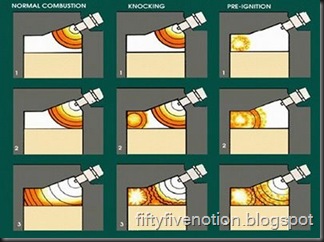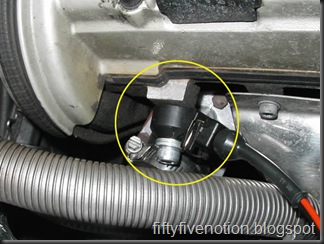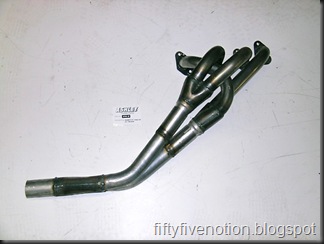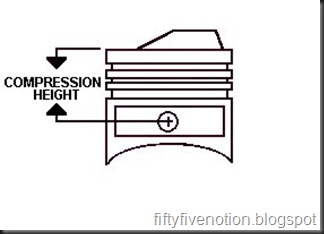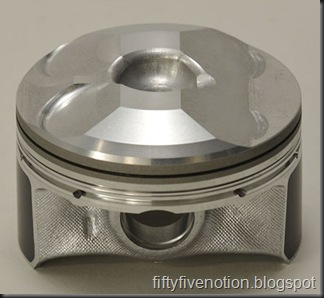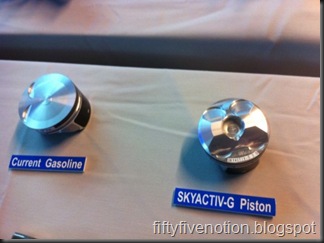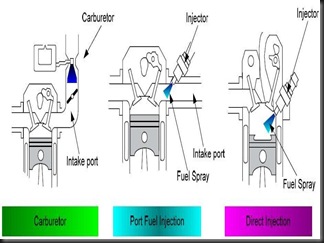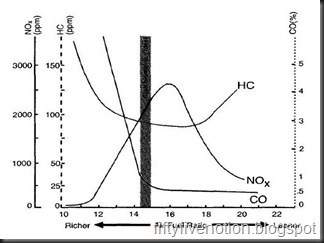Mazda very recently developed a new technology for their Gasoline and Diesel engines known as SKYACTIV, which recently changed the myth of all internal combustion engines. Well myself, being a devotee of Gasoline engines lets see what difference these engine make when compared to the existing ones.
Most of the books or engineering myth states that petrol engines can achieve an compression ratio of 10.5:1 and these days a normal street car have an average compression ratio of 10,Unless and until the engines are designed for a specific purpose like racing or what so ever.
But the engineers in Mazda proved that these myths are wrong which eventually changed the mythoi of internal combustion engines. Yes they are really proud enough in saying that they have made the world’s first mass produced gasoline engine which achieves the compression ratio of 14:1 which is really the highest among the mass produced gasoline engines.
According to thermodynamics increase in compression ratio results in increasing thermal efficiency of the engine , which means chances of engine exposing to higher temperature’s are very high. But increase in thermal efficiency has not only got the adverse effects but also the some better upshots in terms of engine power etc. Smaller capacity race engine with high compression ratio results in better power output. Most critical parts like the Valve face, Piston crown, spark plugs, cylinder wall and the Piston rings are exposed too much higher operating temperatures than the normal engines. This is mainly due to the combustion temperatures or commonly called as in cylinder temperature that are very high in the engine. It increases to an extent that the homogenous mixture starts to ignite them self before the spark actually comes and this phenomena is called as KNOCKING.
KNOCKING:
As you can see in the Image, in normal combustion a homogenous mixture of air and fuel at definite proportions based on the drivers demand is sprayed into the combustion chamber. Just before the piston hits the TDC there is a spark from the spark plug which travels almost to the end of the cylinder wall to make sure that the mixture is completely burnt for producing energy.
Difference between Normal combustion, Knocking and Pre-Ignition
During knocking scenario before the spark reaches the end of the cylinder wall due to the increase in cylinder temperature there is an external spark aid which travels opposite to the flame front and when they both collide they produce a noise which is similar to the sound of “knocking”. There are other factors that also aid in knocking such as poor air fuel mixture etc.
Pre – Ignition is even worse than these where the spark comes much before the AF Mixture is sprayed.
Now in modern engines special sensors called “Knock Sensors” are used to detect the knocking in the engine. When ever the knocking is detected the engine management system either closes the butterfly valve (through which the air comes) automatically or retards the ignition timing so that there is a very less load observed. These sensors are located in the engine block or near the cylinder head.
Location of Knock Sensor
If increasing the compression ratio leads to such an contrary effects how did the Mazda engineers achieve it. The following are the techs that are used by Mazda to achieve it…..
- Variable Valve Timing
- 4-2-1 Motorsport Inspired Exhaust System
- High Compression Engine with an Special design in the Piston
- Last but not the least the Direct Gasoline Injection
4-2-1 Motorsport Inspired Exhaust System:
Normally this kind of exhaust system initially was used in racing engines where each and every RPM is important to get the best out of the engine. 4-2-1 Exhaust system a.k.a 4-2-1 headers or tri-y to may race enthusiastic is mainly known for better low end and mid range responses in racing engines. Mazda applied the same in the skyactiv engines also. Engineering says that by joining various cylinder tubes before the collector multiple pressure waves can be created. Consider a four cylinder engine from which all the four exhaust pipes are joined in to two collectors based on the firing order.
A normal four cylinder engine has a firing order of 1-3-4-2, the exhaust pipes from 1-3 are joined to a common collector so that when the first cylinder begins their exhaust stroke (A positive pulse is produced) the gases takes considerable amount of time to meet the collector and they are also pushed back to the 3rd cylinder (Can also be called as Negative Pulse) ,when the exhaust valve opens in the 3rd cylinder these pulses however hit in the right time to pull the residual gases from the other cylinder provided they are properly tuned.
In any cases the exhaust system plays a considerable role in the performance of the engine. Any exhaust system they work on the principle of resonance. The pipe diameter, length, collector angle its length everything plays a major role in the performance of the engine.
A custom made 4-2-1 racing header
High Compression Engine with an Special design in the Piston:
As discussed earlier high compression means higher expansion to heat, What is this compression ratio is all about and how it plays a major role in Skyactiv engine,
Compression Ratio:
They are nothing but the ratios to the gases are compressed when the piston moves from BDC to TDC.
Imagine an engine with an compression ratio of 10:1 which means there are 100cc air that can be absorbed during inlet stroke and they will be compressed to 10cc when the piston reaches the maximum point. This is called as compression ratio. The more this number the better the performance provided they are under the limits. For a gasoline street engines the typical comp ration will be around 10 to 12:1. Racing engines goes up to 14:1.
TO attain this there are several ways in a engine,
But Mazda uses a domed piston to increase the compression ratio of the engine. Normally one important factor when choosing the domed piston is the compression height. Compression height is nothing but the distance between the centre line of the piston pin (Gudgeon or even known as wrist pin) to the top of the piston.
Compression height of piston
Nowadays all manufacturers are either going for a flat or undercut (Dish) pistons in stock engines. Most of the piston which has domed head is either found in racing or high performance cars. Mazda uses a domed piston which has helped them in getting better compression ratio compared to other competitors.
SKYACTIV-G Piston
Difference among conventional and the skyactiv-G pistons
The difference is as seen, the conventional piston has got an undercut (Dish) and Mazda has gone for a dome shaped piston. The cut in the valves are to make sure that the valves doesn’t hit in the piston when they are at the maximum level. These kinds of engine are also known as interference engine. The cut is mainly to give an extra amount of lift to the valves which sends more amount of air fuel mixture. Moreover some say that these also help in maintaining the compression ratios.
They do have some disadvantages i.e. if anything goes wrong with the timing they collide with the valves and chances of getting valves bent are very high.
Wonder why there is a hole in the middle of the piston???????? Well I feel that in order to have stratified fuel mixture in the engine there is a cavity in the piston head. This might also help in better roll, squish and turbulence of gases present inside the engine.
Stratified charge?????? Wondering what again stratified charge means the density of the air fuel mixture changes when compared to the centre of the piston than to the cylinder walls. There is a very rich mixture which can near the spark plug which can initiate combustion immediately and around the cylinder walls there is a mixture that is lean enough. They are commonly used in Gasoline Direct Injection engines where the amount of fuel in controlled rather controlling the amount of air. Yes Mazda uses gasoline direct injection in this engine.
Gasoline Direct Injection:
As the emission norms gets more rigid thought the world there is always a need of newer technologies that has to be adopted by the manufacturers. One such technology which was commonly accepted by manufacturers was Common rail diesel injection (CRDi) as known to many for diesel engines. Still for gasoline engines some manufacturers accept the MPFi (Multi Point Fuel Injection System) some move ahead with times and they started accepting Gasoline Direct Injection. The first on this league was Mitsubishi way back in the late 90’s.
A detailed explanation on the overall GDi system is discussed here…
What difference does GDi make? How different it’s when compared to other systems? The answer is given in the picture below,
As you can see in the earlier carburetor system both the air and the fuel are mixed and sent to the combustion chamber. There was a very limited control of the fuel which was sent. Moreover altitude compensation, Temperature compensation was very limited.
Then came the Port Fuel Injection in which there was precise control of the fuel which was metered either by sensing the manifold vacuum through MAP sensor or by sensing the mass of air that is entering. By sending these information's to the Engine Control Unit (ECU) the ECU reads its pre-determined or programmed map and sends the right amount of fuel that is required. Maintaining the engine under control was much easier with the PFI system. The engineers were able to meet the emission norms across the globe.
In the second stage of these PFI injection systems the entire system was bought under closed loop by adding one more sensor called Oxygen sensor. With the ECU was able to adjust the fuel demand more precise.
Gasoline direct injection is little bit advanced than the PFI system. Rather than sending the mixture in the manifold the fuel (Gasoline) is injected in the combustion chamber directly like diesel injection. With technologies like this manufacturers are able to get the required power in smaller capacity engines itself. Thus they became more fuel efficient because of the various control systems in the engine electronics.
Working:
Any GDI system works on three modes
Homogenous Mode:
In this mode a stoichiometric mixture is formed in the combustion chamber where the AFR of 14.7:1 is maintained or even richer At this point the emission parameters are well under control. And as we know all modern engines are closed loop engines the AFR are well maintained within the limits through out the range. The fuel is injected when the piston is in the suction stroke. It takes enough time to mix with the considerable amount of air that is already available in the engine. This mode is like any other port fuel injection system.
It’s in this stage where all the emission parameters of an SI engine such as CO,NOx and HC are under the limits.
Emission formation of an SI Engine
In the Image as you can see exactly @ 14.7:1 the exhaust emission’s re well in the control. Anything more say for example 13,12 HC and CO are higher. Leaner mixture results in increase of HC and NOx.Well it doesn’t mean that 14.7:1 is perfectly all right and why do we need some costly exhaust treatments like catalytic converter etc. It’s just because to keep the emission well in limits in for suiting different norms.
Stratified Mode:
This is where the GDI make their presence; these modes are normally used for light load running conditions or at constant speed or even low speeds where the amount of acceleration required is very low or constant. Under these cases the AFR can go up to 30:1 or even higher. The fuel is injected much before power stroke as a small amount of fuel is enough to make the combustion. This fuel which is sprayed should be as near as possible to the spark plug. But the disadvantage is that very lean mixture’s produce NOx emission because of the operating temperature conditions.
Therefore some aid is required to bring the cylinder temperature down. This is where the EGR comes to picture. The EGR (Exhaust Gas Recirculation) dilutes the temperature in the combustion chamber by sending some burnt gases in to the combustion chamber. When the temperature of the charge in the combustion chamber are reduced the cylinder temperature is also reduced thus knocking can be avoided and NOx emission is also under control.
Not forget to mention that there is always a Wideband O2 sensor present in these engines as mixture can vary their ratio rapidly.
Wideband O2????????? Wonder What????? Well as mentioned earlier all port fuel and GDI engines run on closed loop i.e. the system is considerably monitored for giving their maximum efficiency. These O2 sensors tell ECU the exact amount of air present in the exhaust gases. The amount of Oxygen present in the exhaust gases help the ECU to decide if the mixture that was sent is rich or lean.
There are two types of O2 sensor’s Wideband and Narrow band. All low cost engines will have narrow band sensors which can only tell the ECU if the fuel is rich or lean. Not how rich or lean.
Wideband sensors tell ECU the exact digit say 12.5 or even 17 etc in terms of voltage for which they are calibrated.
Homogenous Lean Mode:
This is something between Stratified and Homogenous mode. The AFR value will be around 18:1 etc which is little leaner not so as stratified. Based on the AFR the EGR can also be activated to reduce the in cylinder temperature. They are normally used in light cruising ranges where the engine load is not changed rapidly.
Well that is GDI which helps the Mazda SKYACTIV engines to get better performance and emission and much better efficiency also.
Variable Valve Timing:
Refer my previous post for better explanation on the VVT systems.
The following video explains the working of the Mazda SKYACTIV-G Engine
More Video on GDi Engines
